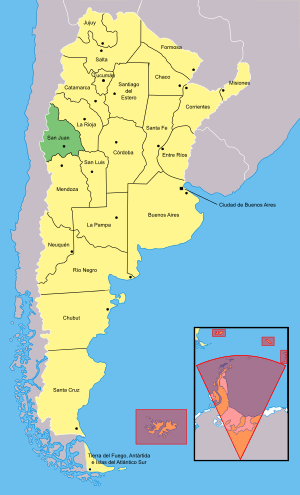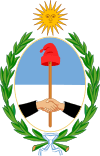San Juan Province, Argentina facts for kids
Quick facts for kids
San Juan
|
|||
|---|---|---|---|

|
|||
|
|||

Location of San Juan within Argentina
|
|||
| Country | Argentina | ||
| Capital | San Juan | ||
| Departments | 19 | ||
| Districts | 100 | ||
| Area | |||
| • Total | 155,488 km2 (60,034 sq mi) | ||
| Population
(2010)
|
|||
| • Total | 680,427 (Ranked 8th) | ||
| Demonym(s) | sanjuanino | ||
| Time zone | UTC−3 (ART) | ||
| ISO 3166 code | AR-J | ||
San Juan is an exciting province located in the western part of Argentina. It shares a border with Chile to the west. This province is famous for its many paleontological sites, where scientists find ancient fossils.
The economy of San Juan relies heavily on farming. They are especially known for producing wine and Olive oil. The province is also a major center for mining and oil production.
Contents
Exploring San Juan's Geography and Climate

San Juan is part of the Cuyo region, which is mostly a dry, semi-desert area. In the east, you'll find flat, dry plains. As you move west, the land quickly rises into huge mountains, some reaching over 6,000 meters (about 20,000 feet) high.
The Zonda Wind and Unique Landscapes
Both the plains and mountains experience a hot, dry wind called the Zonda. This wind is a type of foehn wind. Most of the rain in San Juan happens during the summer, often as strong electrical storms.
This hot wind has shaped the red, clay-rich soil into incredible natural sculptures. Two famous examples are Pampa del Leoncito (a strict nature reserve) and Valle de la Luna (Valley of the Moon). These areas feature 200-million-year-old rock formations that look like they're from another planet!
Rivers and Fertile Valleys
The Jáchal and San Juan rivers are very important to the province. They are part of the Desaguadero River system. These rivers create fertile valleys, which are key to San Juan's economy. The San Juan River eventually flows into the Huanacache lagoons in the southeast.
Mountains and Ice
The Andes mountains in San Juan Province are part of the Dry Andes climate zone. In these mountains, you'll find permafrost (ground that stays frozen) in many places above 3,000 meters (about 9,800 feet). Rock glaciers, which are slow-moving masses of rock and ice, are also common here.
Images for kids
-
Jose Luis Gioja, with Cristina Kirchner, at the opening of the Caracoles Dam.
-
Vineyards at the base of the Andes mountains.
See also
 In Spanish: Provincia de San Juan para niños
In Spanish: Provincia de San Juan para niños










